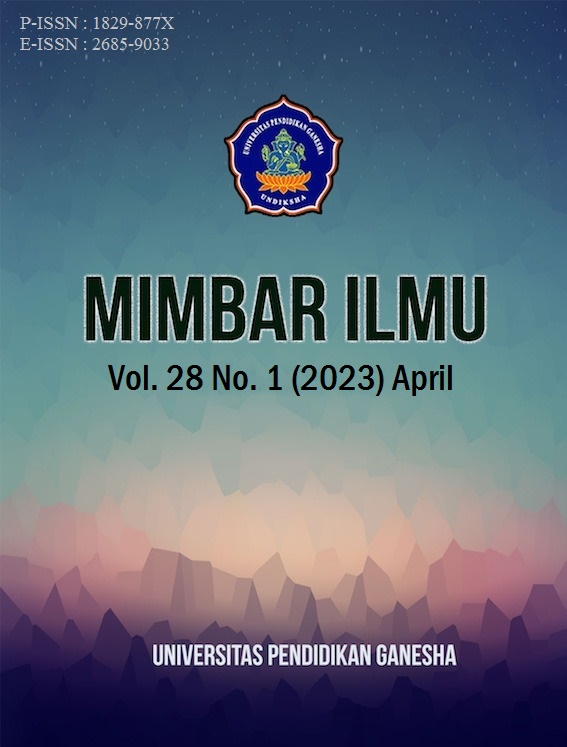Autism Spectrum Disorders and The Development of Children’s Aritmetic Aptitude and Numeracy
DOI:
https://doi.org/10.23887/mi.v28i1.57460Keywords:
Numerical Ability, Autistic Disorder, Inclusive, Elementary SchoolAbstract
Initial numeration is part of the math skills that every student must have. However, children with autistic disorder do not have good initial numeracy skills. This study aims to analyze the initial numeracy abilities of students with autistic disorders. This research is case study research. The subjects of this study were 2 students with autistic disorder class III, namely boys and girls. Data collection techniques used in this study used interviews, observation, and test sheets related to the initial numeracy skills of students with autistic disorders. Data analysis techniques are carried out through several stages, namely data collection, data reduction, data display, and making conclusions. The results showed that D could recognize limited numbers in units 1-9 independently and could add and subtract limited units with assistance. N has not been able to recognize numbers and perform simple arithmetic. However, N can imitate writing unit numbers. The inability to master initial numeracy in students with autistic disorder is dominated by limited interest and attention, as well as brain disorders that cause low speech and language skills that impact numeracy mastery or recognition. So the teacher has an important role in improving his initial numeracy skills.
References
Anders, Y., Rossbach, H. G., Weinert, S., Ebert, S., Kuger, S., Lehrl, S., & von Maurice, J. (2012). Home and preschool learning environments and their relations to the development of early numeracy skills. Early Childhood Research Quarterly, 27(2), 231–244. https://doi.org/10.1016/j.ecresq.2011.08.003. DOI: https://doi.org/10.1016/j.ecresq.2011.08.003
Apanasionok, M. M., Alallawi, B., Grindle, C. F., Hastings, R. P., Watkins, R. C., Nicholls, G., Maguire, L., & Staunton, D. (2021). Teaching early numeracy to students with autism using a school staff delivery model. British Journal of Special Education, 48(1), 90–111. https://doi.org/10.1111/1467-8578.12346. DOI: https://doi.org/10.1111/1467-8578.12346
Aunio, P., Korhonen, J., Ragpot, L., Törmänen, M., Mononen, R., & Henning, E. (2019). Multi-factorial approach to early numeracy—The effects of cognitive skills, language factors and kindergarten attendance on early numeracy performance of South African first graders. International Journal of Educational Research, 97(July), 65–76. https://doi.org/10.1016/j.ijer.2019.06.011. DOI: https://doi.org/10.1016/j.ijer.2019.06.011
Bae, Y. S., Chiang, H. M., & Hickson, L. (2015). Mathematical Word Problem Solving Ability of Children with Autism Spectrum Disorder and their Typically Developing Peers. Journal of Autism and Developmental Disorders, 45(7), 2200–2208. https://doi.org/10.1007/s10803-015-2387-8. DOI: https://doi.org/10.1007/s10803-015-2387-8
Chan, J. Y. C., & Scalise, N. R. (2022). Numeracy skills mediate the relation between executive function and mathematics achievement in early childhood. Cognitive Development, 62(December 2021), 101154. https://doi.org/10.1016/j.cogdev.2022.101154. DOI: https://doi.org/10.1016/j.cogdev.2022.101154
Cox, S. K., & Jimenez, B. A. (2020). Mathematical interventions for students with autism spectrum disorder: Recommendations for practitioners. Research in Developmental Disabilities, 105(March), 103744. https://doi.org/10.1016/j.ridd.2020.103744. DOI: https://doi.org/10.1016/j.ridd.2020.103744
Creswell, J. W. (2013). Qualitative Inquiry & Research Design: Choosing among Five Approaches (3rd ed). Sage.
Damayanti, R. N., Subanji, S., & Sa’dijah, C. (2019). Gesture Anak Autis dalam Menyelesaikan Soal Matematika Materi Penjumlahan Bilangan Bulat. Jurnal Pendidikan: Teori, Penelitian, Dan Pengembangan, 4(9), 1132. https://doi.org/10.17977/jptpp.v4i9.12690. DOI: https://doi.org/10.17977/jptpp.v4i9.12690
Daulay, N. (2017). Struktur Otak dan Keberfungsiannya pada Anak dengan Gangguan Spektrum Autis : Kajian Neuropsikologi. 25(1), 11–25. https://doi.org/10.22146/buletinpsikologi.25163. DOI: https://doi.org/10.22146/buletinpsikologi.25163
Glinik, O. A. (2022). Numeracy Skills Disorders: Review of Causes and Neuropsychological Mechanisms of Dyscalculia. Psychological Science and Education, 27(1), 17–26. https://doi.org/10.17759/PSE.2022270102. DOI: https://doi.org/10.17759/pse.2022270102
Guo, L., Xu, X., Dai, D. Y., & Deng, C. (2021). Foundations for early mathematics skills: The interplay of approximate number system, mapping ability, and home numeracy activities. Cognitive Development, 59(June), 101083. https://doi.org/10.1016/j.cogdev.2021.101083. DOI: https://doi.org/10.1016/j.cogdev.2021.101083
Hannah, K. E., Brown, K. S., Hall-bruce, M., Stevenson, R. A., & Mcrae, K. (2022). Acta Psychologica Knowledge of the temporal structure of events in relation to autistic traits and social ability. Acta Psychologica, 231(October), 103779. https://doi.org/10.1016/j.actpsy.2022.103779. DOI: https://doi.org/10.1016/j.actpsy.2022.103779
Huntsinger, C. S., Jose, P. E., & Luo, Z. (2016). Parental facilitation of early mathematics and reading skills and knowledge through encouragement of home-based activities. Early Childhood Research Quarterly, 37, 1–15. https://doi.org/10.1016/j.ecresq.2016.02.005. DOI: https://doi.org/10.1016/j.ecresq.2016.02.005
Irawan, A., & Febriyanti, C. (2018). Pembelajaran Matematika pada Siswa Berkebutuhan Khusus di Sekolah Inklusi. Journal of Medives : Journal of Mathematics Education IKIP Veteran Semarang, 2(1), 99. https://doi.org/10.31331/medives.v2i1.509. DOI: https://doi.org/10.31331/medives.v2i1.509
Johora, F. T., Fleer, M., & Hammer, M. (2021). Understanding the child in relation to practice and rethinking inclusion: A study of children with autism spectrum disorder in mainstream preschools. Learning, Culture and Social Interaction, 28(October 2020), 100469. https://doi.org/10.1016/j.lcsi.2020.100469. DOI: https://doi.org/10.1016/j.lcsi.2020.100469
Kamaruzaman, M. F., Rani, N. M., Nor, H. M., & Azahari, M. H. H. (2016). Developing User Interface Design Application for Children with Autism. Procedia - Social and Behavioral Sciences, 217, 887–894. https://doi.org/10.1016/j.sbspro.2016.02.022. DOI: https://doi.org/10.1016/j.sbspro.2016.02.022
King, Y. A., & Purpura, D. J. (2021). Direct numeracy activities and early math skills: Math language as a mediator. Early Childhood Research Quarterly, 54, 252–259. https://doi.org/10.1016/j.ecresq.2020.09.012. DOI: https://doi.org/10.1016/j.ecresq.2020.09.012
Kleemans, T., Segers, E., & Verhoeven, L. (2018). Individual differences in basic arithmetic skills in children with and without developmental language disorder: Role of home numeracy experiences. Early Childhood Research Quarterly, 43, 62–72. https://doi.org/10.1016/j.ecresq.2018.01.005. DOI: https://doi.org/10.1016/j.ecresq.2018.01.005
Larson, C., Rivera-Figueroa, K., Thomas, H. R., Fein, D., Stevens, M. C., & Eigsti, I. M. (2022). Structural language impairment in Autism Spectrum Disorder versus Loss of Autism Diagnosis: Behavioral and neural characteristics. NeuroImage: Clinical, 34(January), 103043. https://doi.org/10.1016/j.nicl.2022.103043. DOI: https://doi.org/10.1016/j.nicl.2022.103043
Latifah, L., & Rahmawati, F. P. (2022). Penerapan Program CALISTUNG untuk Meningkatkan Literasi Numerasi Siswa Kelas Rendah di Sekolah Dasar. Jurnal Basicedu, 6(3), 5021–5029. https://doi.org/10.31004/basicedu.v6i3.3003. DOI: https://doi.org/10.31004/basicedu.v6i3.3003
Marlina, M., Winarni, S., Rohati, R., Kumalasari, A., & Barutu, N. K. (2022). Analisis Kemampuan Number Sense Siswa Autism Spectrum Disorder (ASD) di SLB Sri Soedewi Mascjun Sofwan Kota Jambi. Jurnal Cendekia : Jurnal Pendidikan Matematika, 6(3), 2788–2800. https://doi.org/10.31004/cendekia.v6i3.1753. DOI: https://doi.org/10.31004/cendekia.v6i3.1753
May, T., Rinehart, N. J., Wilding, J., & Cornish, K. (2015). Attention and basic literacy and numeracy in children with Autism Spectrum Disorder: A one-year follow-up study. Research in Autism Spectrum Disorders, 9, 193–201. https://doi.org/10.1016/j.rasd.2014.10.010. DOI: https://doi.org/10.1016/j.rasd.2014.10.010
McDougal, E., Riby, D. M., & Hanley, M. (2020). Profiles of academic achievement and attention in children with and without Autism Spectrum Disorder. Research in Developmental Disabilities, 106(April 2019), 103749. https://doi.org/10.1016/j.ridd.2020.103749. DOI: https://doi.org/10.1016/j.ridd.2020.103749
McLeod, S., Harrison, L. J., & Wang, C. (2019). A longitudinal population study of literacy and numeracy outcomes for children identified with speech, language, and communication needs in early childhood. Early Childhood Research Quarterly, 47, 507–517. https://doi.org/10.1016/j.ecresq.2018.07.004. DOI: https://doi.org/10.1016/j.ecresq.2018.07.004
Méndez, L. I., Hammer, C. S., Lopez, L. M., & Blair, C. (2019). Examining language and early numeracy skills in young Latino dual language learners. Early Childhood Research Quarterly, 46, 252–261. https://doi.org/10.1016/j.ecresq.2018.02.004. DOI: https://doi.org/10.1016/j.ecresq.2018.02.004
Ntalindwa, T., Nduwingoma, M., Karangwa, E., Soron, T. R., Uworwabayeho, A., & Uwineza, A. (2021). Development of a Mobile App to Improve Numeracy Skills of Children with Autism Spectrum Disorder: Participatory Design and Usability Study. JMIR Pediatrics and Parenting, 4(3), 1–21. https://doi.org/10.2196/21471. DOI: https://doi.org/10.2196/21471
Rakhmawati, Y., & Mustadi, A. (2022). The circumstances of literacy numeracy skill: Between notion and fact from elementary school students. Jurnal Prima Edukasia, 10(1), 9–18. https://doi.org/10.21831/jpe.v10i1.36427. DOI: https://doi.org/10.21831/jpe.v10i1.36427
Ron-Ezra, M., & Levenson, E. S. (2021). Engaging a third-grade student with autism spectrum disorder in an error finding activity. Journal of Mathematical Behavior, 63(March), 100896. https://doi.org/10.1016/j.jmathb.2021.100896. DOI: https://doi.org/10.1016/j.jmathb.2021.100896
Ryan-Enright, T., O'Connor, R., Bramham, J., & Taylor, L. K. (2022). A systematic review of autistic children's prosocial behaviour. Research in Autism Spectrum Disorders, 98(July), 102023. https://doi.org/10.1016/j.rasd.2022.102023. DOI: https://doi.org/10.1016/j.rasd.2022.102023
Shabrina, L. M. (2022). Kegiatan Kampus Mengajar dalam Meningkatkan Keterampilan Literasi dan Numerasi Siswa Sekolah Dasar. Jurnal Basicedu, 6(1), 916–924. https://doi.org/10.31004/basicedu.v6i1.2041. DOI: https://doi.org/10.31004/basicedu.v6i1.2041
Sheppard, M. E., & Wieman, R. (2020). What do teachers need? Math and special education teacher educators' perceptions of essential teacher knowledge and experience. Journal of Mathematical Behavior, 59(June), 100798. https://doi.org/10.1016/j.jmathb.2020.100798. DOI: https://doi.org/10.1016/j.jmathb.2020.100798
Skwarchuk, S. L., Sowinski, C., & LeFevre, J. A. (2014). Formal and informal home learning activities in relation to children's early numeracy and literacy skills: The development of a home numeracy model. Journal of Experimental Child Psychology, 121(1), 63–84. https://doi.org/10.1016/j.jecp.2013.11.006. DOI: https://doi.org/10.1016/j.jecp.2013.11.006
Tashnim, A., Nowshin, S., Akter, F., & Das, A. K. (2017). Interactive interface design for learning numeracy and calculation for children with autism. 2017 9th International Conference on Information Technology and Electrical Engineering, ICITEE 2017, 2018-Janua, 1–6. https://doi.org/10.1109/ICITEED.2017.8250507. DOI: https://doi.org/10.1109/ICITEED.2017.8250507
Titeca, D., Roeyers, H., Josephy, H., Ceulemans, A., & Desoete, A. (2014). Preschool predictors of mathematics in first grade children with autism spectrum disorder. Research in Developmental Disabilities, 35(11), 2714–2727. https://doi.org/10.1016/j.ridd.2014.07.012. DOI: https://doi.org/10.1016/j.ridd.2014.07.012
Trickett, J., Batchelor, S., Brittle, B., Foulkes, M., Pickering, J., Slocombe, F., & Gilmore, C. (2022). The role of parent-led and child-led home numeracy activities in early mathematical skills. Cognitive Development, 63(May), 101189. https://doi.org/10.1016/j.cogdev.2022.101189. DOI: https://doi.org/10.1016/j.cogdev.2022.101189
Tzanakaki, P., Brown, N., Farmer, K., Fraser-Smith, J., Mcclatchey, K., Mckeown, V., Sangster, A., Shaver, I., & Templeton, J. (2014). An individualised curriculum to teach numeracy skills to children with autism: Programme description and pilot data. Support for Learning, 29(4), 319–338. https://doi.org/10.1111/1467-9604.12069. DOI: https://doi.org/10.1111/1467-9604.12069
Downloads
Published
How to Cite
Issue
Section
License
Copyright (c) 2023 Kemil Wachidah

This work is licensed under a Creative Commons Attribution-ShareAlike 4.0 International License.
This work is licensed under a Creative Commons Attribution-ShareAlike 4.0 International License.
Authors who publish with this journal agree to the following terms:
- Authors retain copyright and grant the journal right of first publication with the work simultaneously licensed under a Creative Commons Attribution-ShareAlike 4.0 International License that allows others to share the work with an acknowledgment of the work's authorship and initial publication in this journal.
- Authors are able to enter into separate, additional contractual arrangements for the non-exclusive distribution of the journal's published version of the work (e.g., post it to an institutional repository or publish it in a book), with an acknowledgment of its initial publication in this journal.
- Authors are permitted and encouraged to post their work online (e.g., in institutional repositories or on their website) prior to and during the submission process, as it can lead to productive exchanges, as well as earlier and greater citation of published work.






